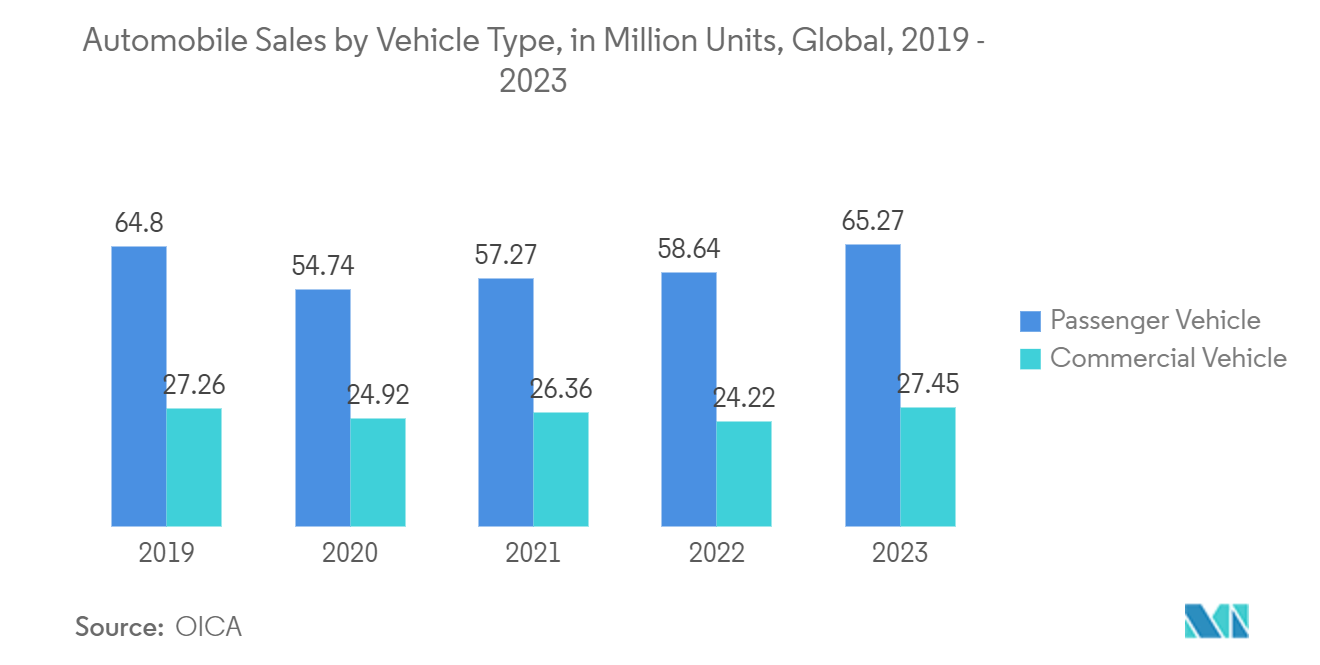Market Trends of Automotive Chip Industry
Passenger Vehicles Segment is Expected to Hold Significant Market Share
- Passenger vehicles are leading the charge in adopting advanced driver-assistance systems (ADAS) and autonomous driving technologies. Integral ADAS features such as lane-keeping assist, adaptive cruise control, and emergency braking rely on various semiconductor components, including sensors, microcontrollers, and AI/ML chips. With the growing sophistication of ADAS and the rising prominence of self-driving features, the semiconductor content in passenger cars is set to rise further.
- The growing adoption of electric and hybrid passenger vehicles is fueling a surge in semiconductor demand. These vehicles rely on various chips to oversee powertrains, batteries, charging systems, and electrical components. As automakers broaden their electric vehicle portfolios, the demand for automotive semiconductors in the passenger vehicle sector is set to escalate. For example, data from EAFO reveals that in 2023, all-electric vehicles constituted 15% of new passenger car registrations in the European Union.
- Consumer demand is peaking in the passenger car market for advanced infotainment systems, seamless connectivity, and timely over-the-air updates. These infotainment systems, digital cockpits, and connected car technologies depend on various semiconductor components. Notably, the semiconductor content for these features is typically more pronounced in passenger vehicles than in their commercial counterparts.
- The passenger vehicle market dwarfs the commercial sector in terms of volume. This disparity enables semiconductor suppliers to harness more significant economies of scale and achieve cost efficiencies when manufacturing chips tailored for passenger cars. Consequently, the heightened production volumes reduce per-unit costs, rendering chips for passenger vehicles more enticing. According to OICA, passenger car sales increased to 65.27 million units globally, compared to 27.45 million unit sales recorded for commercial vehicles.

Asia-Pacific Region is Expected to Grow Significantly
- Asia Pacific is poised to see a substantial surge in demand for automotive chips. Key players like China, Japan, South Korea, and India primarily drive this growth. These nations are home to some of the globe's leading automotive giants, including Toyota, Honda, Hyundai, Tata Motors, and Volkswagen's joint ventures in China. With these automakers setting up extensive production facilities and supply chains in the APAC region, a robust and consistent demand for automotive-grade semiconductor chips has emerged. Furthermore, the proximity of chip manufacturers to these automotive hubs in APAC not only streamlines supply chains but also curtails logistical expenses.
- China, in particular, is the world's largest and fastest-growing market for electric vehicles (EVs), driven by aggressive government policies and incentives. EVs require a much higher number of semiconductor chips per vehicle, ranging from 1,000 to 3,000 chips, compared to 200 to 300 chips in traditional internal combustion engine vehicles. The automotive chip market is significantly driven by the surging demand for chips in vehicles and the swift expansion of the EV market in the APAC region.
- Countries like Japan and South Korea are spearheading the development of cutting-edge automotive technologies in the APAC region. These technologies encompass autonomous driving, connected car features, and advanced driver assistance systems. Such innovations depend on specialized semiconductor chips, including microcontrollers, sensors, and communication processors. Given the APAC region's dominance in automotive technology and its vast manufacturing base, there's a pronounced demand for these sophisticated automotive chips.
- Governments have rolled out supportive policies and initiatives in the APAC region, especially in China, Japan, and South Korea. Aimed at energizing both the automotive and semiconductor sectors, these measures encompass financial incentives, R&D funding, infrastructure investments, and establishing semiconductor manufacturing hubs and technology parks. Such government-driven initiatives have cultivated a conducive environment for the APAC region's automotive chip market's growth.


